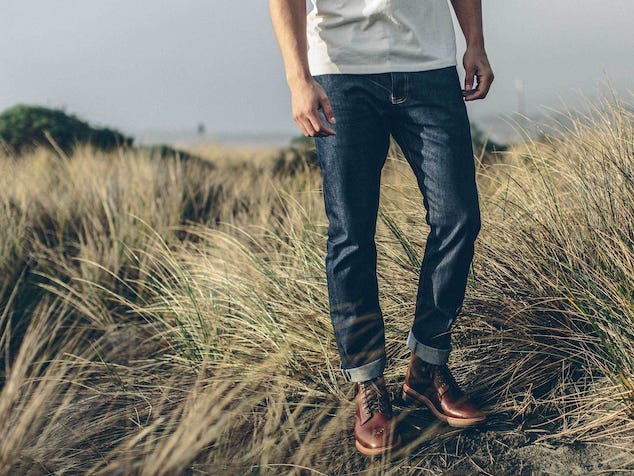
Sustainable denim jeans: What goes into making a pair of jeans and at what cost to the environment, workers and the ways some manufacturers seek to alleviate these issues.
Jeans are one of those items of clothing that grace the wardrobes of almost every person. Jeans have been around for well over a hundred years, and show little sign of going anywhere in the near future.
However, in these modern times, we are becoming more aware of being more eco-friendly and sustainable in all areas of our lives, so just how sustainable are jeans?
On the surface, jeans seem like one of the more sustainable garments, because a pair of good jeans can last many years if taken care of properly, but there is more to jeans than just being long lasting.
Let’s have a look into this interesting question.
Water Usage
Clothing production in general takes an extreme amount of water to create just one item of clothing. It’s estimated that it takes almost three thousand litres of water to create just one t-shirt – that’s enough drinking water for one person for around three years!
Jeans need more steps in its production than a t-shirt, and therefore uses more water, it is estimated that one pair of denim jeans needs almost four thousand litres of water to create them.
Although we appear to have a lot of water on our planet, it is in fact made up of 97% salty water and 2% that is contained in ice and snow, that means there is only 1% freshwater that is available to use for drinking and watering crops.
Many areas of the world are severely water deprived, and it is a sad fact that clothing production is often done within these countries that have a population needing fresh drinking water, and yet most of that water goes to clothing production.
Dyes
Of course, cotton does not naturally occur in shades of blue, and so these colours need to be added to the production to make that signature denim colour.
Dyes and chemicals can be extremely harmful to the environment and the workers alike, with some dyes even being carcinogenic, and considered extremely dangerous.
The majority of denim production occurs in Asia, and there are estimates that around 70% of Asia’s waterways, rivers and lakes are contaminated by the hundred billion litres of waste water that comes from denim production, and is full of these dangerous dyes.
A great deal of Asia’s population is water deprived, and to then have their freshwater supplies diminished even more, is an immense problem.
There are many different brands of denim like freddy push up jeans, so look into what you are buying to check it is sustainable.
Cotton Production
Cotton production is riddled with issues. As we have already seen, it is a crop that needs a huge amount of water.
Cotton is not a huge agricultural crop, it actually only takes up about three percent of agricultural land, but it uses a huge amount of chemicals. In fact, cotton crops use 16% of all the insecticides and 7% of all the herbicides that are used worldwide.
Pesticides are incredibly toxic – that is after all, their job. However these poisons do not only affect nuisance pests, they also impact on the cotton workers.
Many cotton workers, it is thought to be around 4% suffer from acute pesticide poisoning, and around one million cotton workers require hospital treatment for this each year.
These pesticides are not picky about who, or what they harm, and run off of the cotton fields into the local waterways and soils, putting other food crops, humans and animals at risk of poisoning.
The cotton trade has a historically bad reputation, and its link with the slave trade is well known, and undeniable. Unfortunately, there is a lot of evidence that cotton production still uses child labour, and forced labour to reach its targets.
As fast fashion continues to rise, the demand for cheap cotton rises with it, and so this has an impact on the cotton works. The reduced price for cotton crops has an immediate effect on the cotton workers and their income.
Distressed Denim
Distressed denim has been around for many years, and goes in and out of fashion frequently. But, how does distressed denim get that signature look?
Distressed denim has the look that it has been kept outside and open to the elements for some time, however, that is not how the distressed look is achieved, instead it uses a technique called sandblasting.
Sandblasting explains the technique perfectly in its name – the jeans are literally blasted with sand.
Sand is fired at high velocity against the fabric, and this softens the fabric as well as giving it that well known look.
The sand does, however, pose a very significant health risk to those that are working with it. The sand particles are very fine, and can easily be inhaled. Once inhaled, these small bits of sand lodge in the lungs, and stay there. These go on to cause many problems, from breathing difficulties to cancer.
Many workers are again, forced and child labour, and are working in unsafe environments, without access to proper safety equipment.
There are other methods that can produce the same results as sandblasting, such as using sandpaper, however these are more expensive and often more labour intensive, which increases the cost of the garment.

So, What Can You Do?
You don’t have to give up your favourite jeans in order to be more eco-friendly. There are many denim brands who are committed to providing eco-friendly and sustainable denim, and treating all their workers fairly.
When looking at a denim brand, look for one that has a verifiable trade line, and can tell exactly where their cotton came from, and where their cloth is made, so that fairness can be traced.
Many brands will use organic and eco-friendly cotton, and are involved with the fair trade movement.
You can also consider buying second hand, as this is a very eco-friendly way of buying denim.
Also, look for jeans that are only made from cotton, and do not have polyester or elastane in. Products with these have non-sustainable plastics in, and put micro-plastics into the waters when they are washed.






